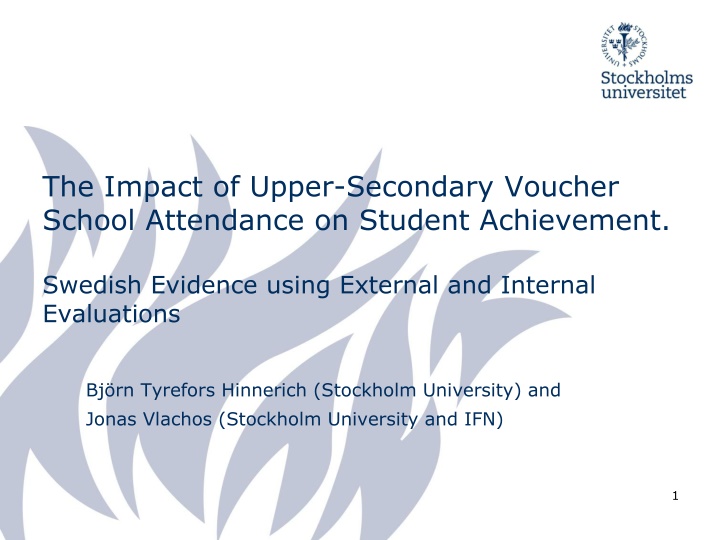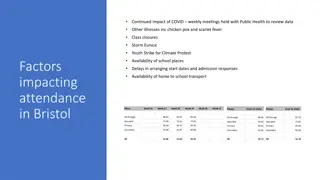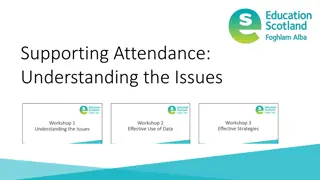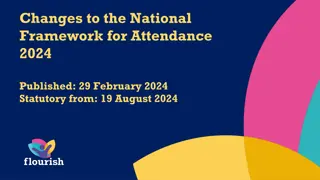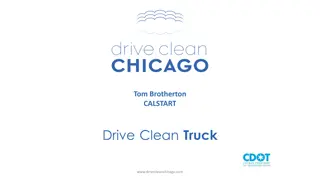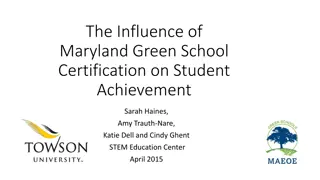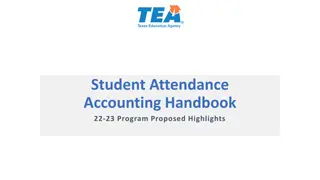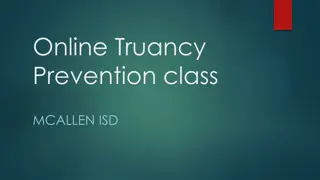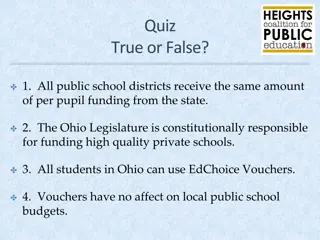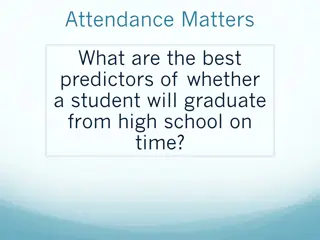The Impact of Upper-Secondary Voucher School Attendance on Student Achievement.
Private provision of publicly funded goods and services, theoretical cases, family demands on academic quality, and previous evidence on private providers of education are discussed in this research, highlighting the complexities and challenges in the education sector.
Download Presentation

Please find below an Image/Link to download the presentation.
The content on the website is provided AS IS for your information and personal use only. It may not be sold, licensed, or shared on other websites without obtaining consent from the author.If you encounter any issues during the download, it is possible that the publisher has removed the file from their server.
You are allowed to download the files provided on this website for personal or commercial use, subject to the condition that they are used lawfully. All files are the property of their respective owners.
The content on the website is provided AS IS for your information and personal use only. It may not be sold, licensed, or shared on other websites without obtaining consent from the author.
E N D
Presentation Transcript
The Impact of Upper-Secondary Voucher School Attendance on Student Achievement. Swedish Evidence using External and Internal Evaluations Bj rn Tyrefors Hinnerich (Stockholm University) and Jonas Vlachos (Stockholm University and IFN) 1
The private provision of publicly funded goods and services Private providers potentially more sensitive to demands of consumers and competitive pressures Private provision => cost effective quality improvements? Private provision => better balance between conflicting goals? Friedman (1955/1962); Hoxby (2003) on educational vouchers. Shleifer (1998) and many others more generally 2
Theoretical case not clear What about the demand Difficult to infer school quality What do families regard as high quality Contracting difficulties Private providers may respond more strongly to incentives May exploit informational disadvantage Is educational quality a private or public good? 3
What do families demand? Academic quality (Hastings et al, 2009; Burgess et al, 2015) Yes, but difficult to separate from student quality High achieving/High SES value academic quality more Peers (eg Burgess et al, 2015; S derstr m & Uusitalo, 2010) Ethnicity/SES/Friends Questionable that peers matter much for academic outcomes (Angrist, 2014) School quality attributes (among them distance, facilities etc) Relative valuation differs between families (Jacob and Lefgren, 2007) Positive house price response to investments in school facilities (Cellini et al, 2010) 4 May well be demand for low value-added schools
Previous evidence on private providers of publicly funded education Charter schools: mixed evidence ~zero average effect. Generally positive in less advantaged areas, sometimes large (survey Clark et al, 2015) UK academies positive in less advantaged areas (Eyles and Machin, 2015). Generalizes to other areas (Eyles et al, 2015)? Vouchers: mixed evidence Large negative impact of Louisiana vouchers for private schools to students at low-performing public schools (Abdulkardioglu et al, 2015) Hard to find consistent pattern regarding private provision Surveys: Neal (2009); Rouse and Barrow (2009); MacLeod and Urquiola (2012); Epple and Romano (2015) 5
Upper-secondary voucher schools in Sweden Liberal and universal system Universal vouchers (no top-up fees) Everybody actively choses school-program (no default school) Open to different providers (for-profits, non-profits) Relatively free entry: 25% voucher school students (<0.5% in 1992), ~85% of these in for-profits Little research in economics of voucher schools of upper- secondary voucher schools in Sweden At compulsory level: ~13% voucher students 6
Upper-Secondary Choice in Sweden Joint school-program choice (selection mainly based on GPA9) Academic (6) and vocational (12) programs Program choice is arguably more important than school choice Findings in previous literature. Given GPA9 High SES more prone to apply to academic programs (Erikson and Rudolphi, 2010) Immigrant students more prone to apply to academic programs (Jonsson and Rudolphi, 2011) Gender differences in program choice (Jonsson, 1999) 7
Upper-Secondary Choice in Sweden Sociological literature on upper-secondary choice in Sweden stresses various determinants Social hierarchy (economic/cultural capital) Geography (accessability) Gender (mainly between vocational programs) Main references: Forsberg, 2015; Lidegran, 2009; Broady and B rjesson, 2008; Palme, 2008 Provider does not matter per se, but endogenously schools locate/market themselves Commercial voucher schools tend to be centrally located Non-profits have an elite profile 8
Empirical challenges Selection: non-random assignment Value-added: Biases small not non-zero (Angrist et al, 2015) We augment VA with very detailed background data Outcomes In Sweden grades and test scores usually locally set We have access to a large set of regraded tests (and the internal evaluations of the same tests) 9
Our results: voucher school impact Negative average impact on external test scores: -0.06 sd Especially students at vocational programs w/o highly educated parents: -0.17 sd Students at academic programs with highly educated parents: ~zero More lenient internal test grading: 0.14 sd More pronounced at academic than vocational programs 10
Data Standardized tests in core subjects (1st year) Swedish, English, and mathematics Regraded by the Swedish School Inspectorate (Intransparent) sampling based on school size If less than 100 students, all sampled Teacher entries and student id s erased Regraded by certified teachers with prior experience 48 073 tests, 27 422 students Matched with student/family data Achievement in compulsory school (GPA9, subject grades) Register data on family and student characteristics 11
Sample vs population Share voucher students Share voucher students at corporate schools Compulsory school GPA (municipal) Compulsory school GPA (voucher) The total number of observations in the sample is 48,073 and there are 27,422 individual students. Sources for population data are a) SOU (2013:56) and b) Skolverket (2013a). (1) (2) Sample .22 .86 219 212 Population .25a) .88a) 218b) 212b) 12
Selection to voucher schools Upper-secondary school .3 .25 .2 Share voucher .15 .1 .05 0 1 2 3 4 5 6 7 8 9 10 GPA9 decile 13
Voucher school location (municipality) VARIABLES Income High edu share Right share Ln population Ln pop density Unemp rate Observations R-squared Bivariate regressions where the dependent variable is the share of upper-secondary voucher students. The explanatory variables are (log) municipal per capita income, the share of municipal adult population with at least three years of post-secondary education, the 2010 municipal vote share for right wing parties (Moderaterna, Kristdemokraterna, Centern, and Folkpartiet), (log) population size, (log) population density, and the municipal unemployment rate. All variables are from Statistics Sweden (Statistikdatabasen) and refer to the year 2011. Robust standard errors in parentheses.*** p<0.01, ** p<0.05, * p<0.1. (1) (2) (3) (4) (5) (6) Municipal share upper-secondary voucher students 0.523*** (0.079) 0.717*** (0.100) 0.480*** (0.075) 142 142 142 0.330 0.365 0.224 0.052*** (0.007) 142 0.194 0.042*** (0.005) 142 0.390 -2.666*** (0.567) 142 0.166 14
Main empirical specification ?????= ?0+ ?1???? ????+ ?2?(????? 1) + ?3,????????? 1 ? ?4+ ??+ ??? 1+ ??+ ??+ ?????. +?? Outcomes: standardized test score or diff between internal & external Past achievement: Flexible GPA9 and subject grades Municipal FE:s (resources, management, LM opportunities) Compulsory school FE:s (grading standards, location, peers) Program FE:s Regrader FE:s X:s: gender, immigration status (including im age), q-of-birth, parental education (8 groups), income (flexible), civil status, employment status, welfare, age, immigration, family size, imputed values of cognitive and non-cognitive skills 15 SE:s clustered by upper-secondary school (treatment level)
Weighting Weight1 (always): Different number of tests in subjects Weigh to treat all subjects equally Weight2: Reweight by 1/(school sample size) Treat all schools as equally sized Weight3: Reweight by (eligable students)/(school sample size) Give schools weights according to actual size 16
Main results 17
Robustness Level-by-field of education (60) and occupational groups (28) Reweight to equally sized schools (weight2) Reweight to population sized schools (weight3) Coursened exact matching (GPA, immigrant, subject, gender, county) Replace municipal FE:s with local labor market FE:s + municipal controls Restrict sample to municipalities with both types of schools Minor differences (municipality FE:s matter somewhat) Levels {-0.045; -0.06} Diffs {0.125; 0.156} 18
Heterogenity: by GPA9 quintile OLS by GPA9 quintile OLS: Levels OLS: Diffs .2 .2 .1 .15 0 .1 -.1 .05 -.2 Q1 Q2 Q3 Q4 Q5 Q1 Q2 Q3 Q4 Q5 19
Heterogeneity: by characteristic voucher Male Foreign High ed Observations 48,073 R-squared (1) (2) (3) Immigrant External (4) (5) (6) Gender Education External External -0.032 0.143*** -0.067*** 0.133*** -0.079*** 0.132*** (0.025) (0.024) (0.024) -0.049 -0.018 (0.032) (0.023) 0.075** (0.034) 48,073 48,073 0.437 0.138 0.437 Diff Diff Diff (0.023) 0.005 (0.031) 48,073 0.138 (0.024) 0.097*** (0.026) 48,073 0.437 (0.022) 0.006 (0.025) 48,073 0.138 20
Heterogeneity: by program & parental education Voucher Other ac Science High ed Observations 48,073 R-squared (1) (2) Diff (3) Vocational External (4) (5) (6) Academic External External -0.094** 0.137*** -0.167*** 0.083** -0.041* 0.145*** (0.037) (0.031) (0.043) 0.049 -0.005 (0.039) (0.033) 0.137** -0.011 (0.055) (0.069) 0.117* (0.062) 48,073 18,247 0.437 0.138 0.436 Diff Diff (0.036) (0.023) 0.000 (0.057) (0.026) 18,247 0.218 (0.025) 0.028 (0.027) 29,826 0.173 0.046* 29,826 0.442 21
Does provider type matter? VARIABLES External Corporate Non-corporate -0.053 0.143*** (0.037) Observations 48,073 R-squared 0.437 (1) (2) OLS Diff -0.056** 0.132*** (0.025) (0.024) (0.049) 48,073 0.138 22
Can differences in resources account for results? VARIABLES voucher Teacher density 0.005* Teacher cred Observations R-squared (1) (2) (3) Vocational External (4) (5) (6) All Academic External External -0.050 0.155*** -0.199*** 0.135** -0.027 0.156*** (0.034) (0.030) (0.064) 0.005 -0.008 (0.003) (0.004) (0.006) -0.000 0.001 -0.001 (0.001) (0.001) (0.002) 48,073 48,073 18,247 0.437 0.138 0.436 Diff Diff Diff (0.054) (0.031) 0.014* (0.007) (0.004) 0.001 (0.001) (0.001) 18,247 0.218 (0.034) 0.000 (0.004) 0.000 (0.001) 29,826 0.173 0.005 -0.000 29,826 0.442 23
Aggregate/general equilibrium effects Estimate at municipal level ~B hlmark and Lindahl (2015) Noisy estimates Negative point estimates 24
Summary and discussion Negative voucher impact on core subject knowledge: 0.06 sd Most pronounced among vocational students w/o highly educated parents (-0.17 sd) Around zero among academic students with highly educated parents Around zero among students with immigrant background (cf Jonsson and Rudolphi, 2011) More lenient test grading in voucher schools: 0.14 sd More at academic than vocational programs 25
Summary and discussion Consistent with voucher schools being more sensitive to differences in demand Academically ambitious students get higher test scores What does vocational students get? Evaluations of vocational programs at vouchers schools stress quality problems in vocational training and non-core subject education (Skolinspektionen, 2011, 2013; Skolveket, 2013) Is information the problem? Results for students with immigrant background suggest not No differences between corporate and non-corporate providers Resources cannot account for results 26
Summary and discussion Caveats Not ideal identification Only first year of upper-secondary school No hard evidence on other quality dimensions External test scores not immune to manipulation (eg teaching-to-the- test) Caution against generalizing to compulsory level Default schools, parents have more say on choice, no ability selection, stricter regulation of curriculum 27
